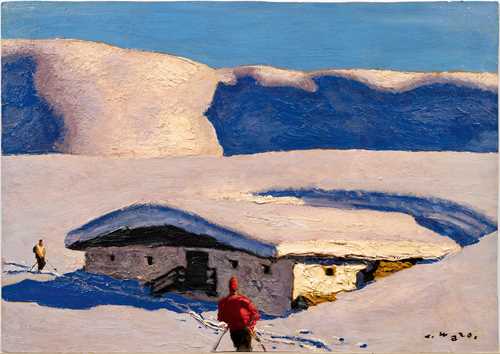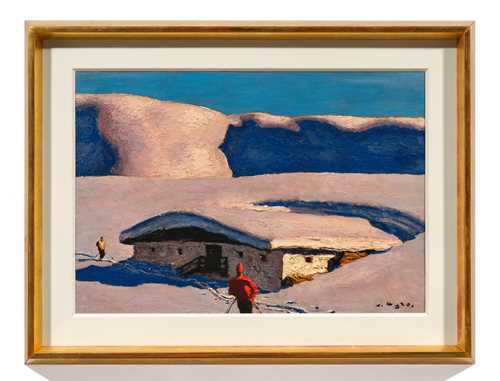
Lot 3241 - A207 Impressionist & Modern Art - Friday, 01. December 2023, 04.30 PM
ALFONS WALDE
(Oberndorf 1891–1958 Kitzbühl)
Skifahrer bei der Alm. (skier in the Alps) 1933.
Oil on board.
Signed lower right: A. Walde.
Signed, inscribed and dated verso on a label: "Skifahrer bei der Alm" / Alfons / Walde / Kitzbühel, Tirol, Austria / 1933.
Signed, inscribed and dated verso on a label: "Skifahrer bei der Alm" / Alfons / Walde / Kitzbühel, Tirol, Austria / 1933.
42 × 59 cm.
Our thanks to Prof. Dr Gert Ammann for confirming the authenticity of this work.
Certificate:
Prof. Dr Gert Ammann, Völs, 11.10.2023 (no. D-LA-797).
Provenance:
- Private collection, Germany.
- Sale Dorotheum, Vienna, 29.11.2005, Lot 142.
- Private collection, Switzerland, acquired at the above auction.
Alfons Walde was born with a love for the snow-covered Tyrolean Alps and Kitzbühel. He was born in Tyrol and the Walde family moved to Kitzbühel at an early age. Walde was always very interested in Kitzbühel tourism and actively helped promote it. As a passionate skier and mountain guide, he knew the mountains and the Tyrolean landscape very well. Due to his original training as an architect, he also had a particular preference for compact forms, which was reflected in his painting.
As early as the 1920s, Walde established himself as a renowned "mountain painter" and was able to acquire effortlessly new commissions from art lovers and collectors, who generally asked for typical Tyrolean mountain motifs. Thanks to his advertising posters, which were at the forefront of the Tyrolean tourism industry, and a unique contract with a postcard company, he was extremely popular in the 1920s, which even enabled him to build his own house on the Hahnenkamm.
In the 1930s, however, the economic crisis also affected tourism in Tyrol. In addition to the decline in tourists for economic reasons, the year 1930 also brought a change in the artist's personal life. His marriage ended in divorce in 1929, and in 1930 he married Lilly Walter. Their daughter Guta Eva was born in the same year. This was a profound new beginning at a time of great global uncertainty.
Nevertheless, Walde was not deterred. Even during this time of upheaval, he repeatedly returned to successful subjects of earlier years and created numerous paintings with almost identical compositions. From 1930 onwards, a new element emerged in his series of lonely mountain farms. He filled his otherwise typically deserted winter landscapes with farmers, touring skiers and the classic subject of mother and child.
Alfons Walde's paintings from this period are not only impressive depictions of the Tyrolean Alps, but also profound reflections on the intimate connection between humans and nature. They tell stories of hard work in the mountains, of adventures in the snow and of the tender bond between parents and children.
Ultimately, the fact that he repeatedly painted the same subject is understandable in a time of political and economic crises: Alfons Walde, the "mountain man," did not strive for change and upheaval, but found peace and reassurance in constancy.
Certificate:
Prof. Dr Gert Ammann, Völs, 11.10.2023 (no. D-LA-797).
Provenance:
- Private collection, Germany.
- Sale Dorotheum, Vienna, 29.11.2005, Lot 142.
- Private collection, Switzerland, acquired at the above auction.
Alfons Walde was born with a love for the snow-covered Tyrolean Alps and Kitzbühel. He was born in Tyrol and the Walde family moved to Kitzbühel at an early age. Walde was always very interested in Kitzbühel tourism and actively helped promote it. As a passionate skier and mountain guide, he knew the mountains and the Tyrolean landscape very well. Due to his original training as an architect, he also had a particular preference for compact forms, which was reflected in his painting.
As early as the 1920s, Walde established himself as a renowned "mountain painter" and was able to acquire effortlessly new commissions from art lovers and collectors, who generally asked for typical Tyrolean mountain motifs. Thanks to his advertising posters, which were at the forefront of the Tyrolean tourism industry, and a unique contract with a postcard company, he was extremely popular in the 1920s, which even enabled him to build his own house on the Hahnenkamm.
In the 1930s, however, the economic crisis also affected tourism in Tyrol. In addition to the decline in tourists for economic reasons, the year 1930 also brought a change in the artist's personal life. His marriage ended in divorce in 1929, and in 1930 he married Lilly Walter. Their daughter Guta Eva was born in the same year. This was a profound new beginning at a time of great global uncertainty.
Nevertheless, Walde was not deterred. Even during this time of upheaval, he repeatedly returned to successful subjects of earlier years and created numerous paintings with almost identical compositions. From 1930 onwards, a new element emerged in his series of lonely mountain farms. He filled his otherwise typically deserted winter landscapes with farmers, touring skiers and the classic subject of mother and child.
Alfons Walde's paintings from this period are not only impressive depictions of the Tyrolean Alps, but also profound reflections on the intimate connection between humans and nature. They tell stories of hard work in the mountains, of adventures in the snow and of the tender bond between parents and children.
Ultimately, the fact that he repeatedly painted the same subject is understandable in a time of political and economic crises: Alfons Walde, the "mountain man," did not strive for change and upheaval, but found peace and reassurance in constancy.
CHF 250 000 / 350 000 | (€ 257 730 / 360 820)
Sold for CHF 425 000 (including buyer’s premium)
All information is subject to change.


